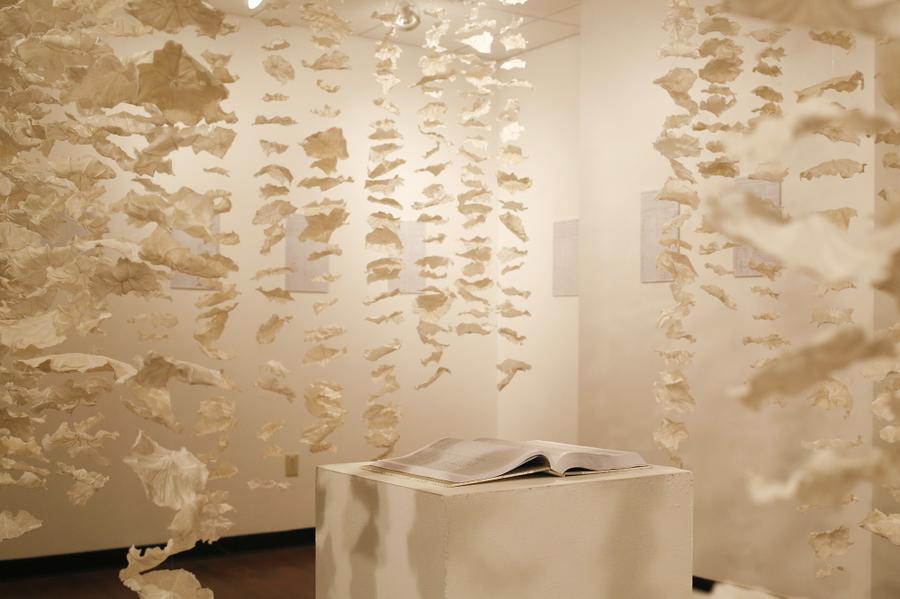“The story is told, of the people who love the land.” These words are the final phrases of the Hawaiian song “Kaulana Nā Pua,” also known as “Famous are the Flowers.” Artist Allison Milham’s most recent project is heavily influenced by this song, even using the English translation as its name.
Her two-week show at the Craft Studio opened Thursday, April 30. Milham, with a flower in her hair, played the ukulele and sang her project’s namesake song in Hawaiian.
Like the song, Milham’s installation is a battle cry for the movement against the general disrespect of Hawaiians and their land.
Milham has been interested in art since high school. She received her undergraduate degree from San Francisco State University, then attended graduate school at the University of Alabama, where she studied book arts. However, the Hawaiian influence did not appear until more recently.
Although Milham is Hawaiian on her mother’s side, she never truly grasped the struggles that go along with that until she was at a family reunion about five years ago and listened in on a late-night conversation between her mom, uncle and aunt.
“They talked about feeling ashamed and the pressure to assimilate into American culture,” Milham said. “That got me thinking about what I could do, living on the other side of the country in Florida. I wanted to help this movement and help share this story.”
From there, Milham learned more about Hawaii’s history, particularly the fact that Hawaiians did not want to become a state. Native Hawaiians gathered thousands of signatures in protest to their annexation in what became known as The Kū‘ē Petitions.
“This was one of two petitions that were gathered,” Milham said. “Together they represent 99 percent of native Hawaiian population at the time. It’s because of these documents that the Treaty of Annexation didn’t pass through Congress.”
The U.S. annexed Hawaii anyway, but to this day, many native Hawaiians consider themselves an illegally occupied nation, not a U.S. state.
Milham’s first project inspired by this history was her thesis, Legacies of Liliuokalani. The project centered around the last queen of Hawaii, Queen Liliuokalani. The project included a record, allowing Milham to include her love of music as well.
“I’ve grown up playing piano and guitar and I also play a little bass, accordion, ukulele, and I sing,” Milham said. “I like to find ways to incorporate my love of art with my love of music.”
Milham wanted to continue this theme of Hawaiian history by creating a piece about the petitions. She was inspired by the work “Blood Swept Lands and Seas of Red,” an installation in London that consists of 888,246 ceramic poppies, each representing a British soldier killed in war.
“I like the idea of visually representing the numbers as a way of honoring these ancestors who stood in opposition to annexation,” Milham said.
Her idea really took off at a workshop this summer, where she met Tamryn McDermott, president of the MU Fiber Arts Club.
“This past summer Allison and I were studio assistants for Jo Stealey, who is the head of the fiber arts program at MU,” McDermott said. “She was teaching a workshop in sculptural papermaking at Penland School of Crafts in North Carolina. In that workshop, the three of us got to talking about different ideas, and Allison told us about this particular idea. So over the course of the two-and-a-half week workshop, we came up with a plan.”
The plan was to create flowers out of overbeaten abaca. Milham plans to create a total of 21,000 flowers to represent 21,000 Hawaiians who signed the treaty. The size of the flower correlates to the age group of the person when they signed the treaty.
The flowers were strung in groups of 24 to represent the 24 names in each column of the treaty.
“The strings of flowers almost look like vertebrae, which I like because the name of the petition, Kū‘ē, translates to ‘protest’ or to ‘stand tall,’” Milham said. “The first part of the word, Kū, means ‘spine.’”
Although Milham likes the stringed appearance, she expects the presentation to vary from venue to venue, perhaps experimenting with magnetized flowers on gallery walls.
Over the course of this week, Milham produced about 1,000 flowers with the help of several of the art classes. However, MU was only phase one.
“This week was her first rendition, or execution, for this ongoing project,” Stealey said. “It’s marked her launching her cross-country tour and saga.”
Milham plans on continuing to travel and work with different groups, spreading the message of Hawaii and their long history of resistance.
She will be visiting her mom in Hawaii in two weeks and plans on also running a more informal workshop with some community members there.
Overall, Milham expects the project to take a year or two, but she is already thinking ahead to the finished product.
“I’d like for it to be permanently installed in Hawaii, perhaps wrapped around the statue of Queen Liliuokalani,” Milham said.








